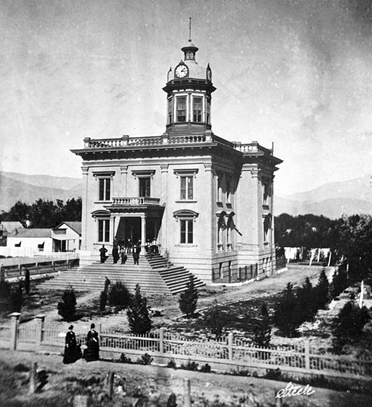San Bernardino Railroads
(Ingersoll)Between 1865 and 1875, San Bernardino was kept in a state of almost constant agitation upon the subject of railroads. It was inevitable that a transcontinental line would some time enter Southern California, and the probabilities were largely in favor of either the San Gorgonio or Cajon Passes as the gateway for admission. Railway connection with Wilmington and Los Angeles and with San Diego was also certain, yet year after year passed by and rumors, organizations, surveys and talk all had no practical results. The Texas Pacific, the Narrow Gauge Coast line, the Narrow Gauge between San Diego and San Bernardino, the Los Angeles and Independence, and a dozen other projects loomed up and faded out of existence, although in a number of cases work was actually begun.
The growth of San Bernardino county and city was slow during these years of waiting; there was no rushing in any direction—the citizens mostly seem to have been satisfied with an ideal climate, a comfortable living and existing conditions. Yet both the county and the town made substantial progress, as has been seen.
In April, 1874. the Southern Pacific road reached Spadra, twenty-five miles east of Los Angeles, and there came to a standstill. The next move appeared uncertain and San Bernardino watched for it anxiously. There were various railroad meetings, much discussion and great hopes. It was not until fall that the railroad officials got around to San Bernardino and then they offered little encouragement. The town was off their direct route, and they could not afford to deflect a transcontinental line, thev said. When it began to be hinted that the depot might be located at Colton rather than San Bernardino, the citizens seem to have regarded this as too absurd for serious consideration. Later, after conferences with the Southern Pacific officials, San Bernardino found that she might "get left." but she still ridi- culed the idea of a rival town at Colton. It was a serious blow to the hopes of the county seat when the depot was finally built at Colton. yet from the coming of the railroad must be dated a new era in the growth and prosperitv of San Bernardino county.
In 1874, San Bernardino began to take on city airs. The new Court House—now the "Old Court House"—was built and was the pride of the county, although there had been much discussion and a good deal of opposition to the "excessive expense" before the plans and location were agreed upon. With the approach of the railroad, the influx of many strangers, and the numerous improvements entered upon, there was a change of spirit in the "Forest City." The Guardian in an editorial thus expatiates:
- "San Bernardino lay dormant too long. Shrouded in her isolation, like
a pretty girl's face behind a veil, the outside world was in ignorance of her
healthful and fertile valley, her matchless climate and her gold ribbed mountains. Besides, while population was sparse, San Bernardino was too far from 'Frisco to attract much attention. And, then, Los Angeles with her
beautiful groves and fertile fields stood like a smiling syren, with open arms
to welcome every stranger who came along. But all this is changed. Emigrants are pouring across the mountains by thousands—coming in search
of cheap lands, and invalids in search of rejuvenating climate. We ought to and will secure our share of this population. Again, money is becoming
more plentiful, and capital can wish for no more profitable nor sure speculative field than this county. But. it is idle to expect that people, whether men in search of land, or men in search of investment, will come by chance. They must be informed of the advantages which we hold out to them—of our waste lands and their fertility. our facilities for manufactures, our undeveloped mines, our immense forests—in short of the countless opportunities open alike to wealth and work."
history of sbco - ingersoll
Railroad History
Railroads
Railroad Building
*

1930s Southern Pacific Railroad 4-4-0

First San Bernardino County Court House 1874
In 1858, the county built its first building, a jail, and rented a residence built originally by Q.S. Sparks at the corner of Fifth and E, to serve as the county offices until 1862, when court was moved to the former residence of Charles Glasier. This was a two-story wooden building and served until the first court house was completed in 1874 or 1878. The first courthouse was a two-story structure topped by a cupola, costing approximately US$40,000 to complete. Judge Thomas was succeeded by A.D. Boren in 1857; although M.H. Crafts won a considerable number of votes in the election of 1861, Judge Boren continued to serve as Crafts failed to follow up. Judge Boren served until 1871, succeeded by Judge Henry M. Willis, who would serve until the Superior Court system was implemented in 1879. The first Superior Court judge was H.C. Rolfe, who had previously served as the District Judge from 1872 to 1875. The 1874 courthouse served until 1898, when the second courthouse was completed.